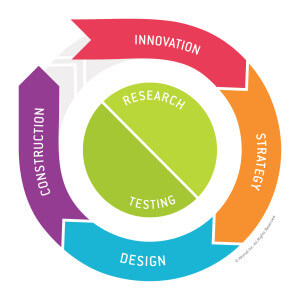
UX Process: The Difference Between Success and Failure
The benefits of following a process are known far and wide by those with one. In UX specifically, a UX process can help align departments and timelines, define partnerships and roles, and induce collaboration. It can mean the difference between a product that lives and a product that dies. Let’s apply this in life and see what happens.
Imagine some friends have invited you to go camping up North. You jump in the car and go because everything you need is already there, right? You arrive at the campsite only to realize that you overlooked the need for a tent and a sleeping bag to sleep in. As the sun sets, your friends are busily gathering wood for the campfire and prepping for dinner, but you neglected to bring matches or pack food. And as the stars come out, you also notice you forgot a flashlight (torch) to light your way in the pitch-black forest. How is this experience turning out? A little research, planning and communication would have turned this into a great experience instead of the nightmare it’s become.
Most people know to plan for trips like that. When it’s your own life, you take precautions to ensure success. So why not take the same care in your work? Sure it’s not life or death, but it most definitely is success or failure.
A process is a plan. A UX process gives structure to a project, a framework where everyone understands their roles and responsibilities. Lack of process is a sign of an immature organization. Without defining what everyone is doing when and without putting stakes in the ground to give some structure to the project, things are sure to go off the rails. And that’s not fun for anybody.
Establishing a UX process
Establish the Team that you Need
This team should cover all aspects of the project (project manager, product manager, engineers, user researchers, interaction designers, visual designers, front-end coders, back-end coders, marketing, sprint planners).
Have a Meeting to get Everyone on the Same Page
Define everyone’s role. The entire team should be working toward the same goals. The product owner wants to release the best possible product into the marketplace. Without a team on their side, this isn’t going to happen.
If there are Holes in your Team, Fill Them
Don’t expect your coders to be designers. Understand the importance of finding an ally. Assemble a team that can help you make your vision a reality. Sometimes making the leap and hiring an experienced research, design and testing team can be the difference between your product ideas becoming a reality and utter failure.
If you follow an agile methodology, remember agile is a coding methodology, not a research or design methodology. Let the experts get ahead of your sprints by conducting a “sprint 0â€Â. This is a period of time (anywhere from 4-12 weeks) before coding starts reserved for conducting relevant user research, establishing the interaction design and getting the visual design approach in a place where it can be applied systematically to a significant number of screens.
Streamline the Review Process
Determine who needs to be a part of the reviews (development leads, marketing and product management, and any corporate project sponsors are critical) and ensure that those people are there. Anyone that has the potential to derail the project at any point should be present in all review meetings.
Give the Reviews the Attention they Deserve
Pay attention. Don’t check emails or step out for phone calls. As you are reviewing the design, think about the approach from the angle of your defined users. Think about the viability and coding limitations. If there is a feature or approach that you like, but it’s not feasible, line it up for a future release.
Trust your Design Team
They are the experts and will guide you through the design process. Remember that design by committee doesn’t work. What does work is using user research to inform the design. So let the designers apply the research and develop appropriate interaction and visual solutions that fit your user’s needs.
Remember that in order to have a great product experience, users need to love the product. It needs to work as intended and meet or exceed their expectations. Proper planning and a proven UX process are a sure way to get you to that vision. Jumping into a moving car without your gear or an understood plan is sure to fail.
To learn more about Akendi’s UX process
Comments
Related Articles





Great blog Athena!,
Your comments about working design and research into agile are particularly pertinent to projects I’ve seen go astray in the past. I also think your comments about the importance of people paying attention during design reviews is important. I find it is especially difficult to get stakeholders to pay attention and provide feedback during wireframe or information architecture reviews. Feedback at this stage can simplify visual review sessions and make the whole process faster and easier.